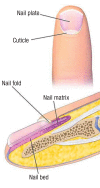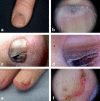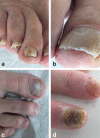The Diagnosis and Treatment of Nail Disorders
- PMID: 27545710
- PMCID: PMC5527843
- DOI: 10.3238/arztebl.2016.0509
The Diagnosis and Treatment of Nail Disorders
Abstract
Background: Nail disorders can arise at any age. About half of all nail disorders are of infectious origin, 15% are due to inflammatory or metabolic conditions, and 5% are due to malignancies and pigment disturbances. The differential diagnosis of nail disorders is often an area of uncertainty.
Methods: This review is based on publications and guidelines retrieved by a selective search in PubMed, including Cochrane reviews, meta-analyses, and AWMF guidelines.
Results: Nail disorders are a common reason for derma - tologic consultation. They are assessed by clinical inspection, dermatoscopy, diagnostic imaging, microbiological (including mycological) testing, and histopathological examination. Some 10% of the overall population suffers from onychomycosis, with a point prevalence of around 15%. Bacterial infections of the nails are rarer than fungal colonization. High-risk groups for nail disorders include diabetics, dialysis patients, transplant recipients, and cancer patients. Malignant tumors of the nails are often not correctly diagnosed at first. For subungual melanoma, the mean time from the initial symptom to the correct diagnosis is approximately 2 years; this delay is partly responsible for the low 10-year survival rate of only 43%.
Conclusion: Evaluation of the nail organ is an important diagnostic instrument. Aside from onychomycosis, which is a common nail disorder, important differential diagnoses such as malignant diseases, drug side effects, and bacterial infections must be considered.
Figures



References
-
- Haneke E. Anatomy of the nail unit and the nail biopsy. Semin Cutan Med Surg. 2015;34:95–100. - PubMed
-
- Zaias N, Escovar SX, Zaiac MN, et al. Hyponychium abnormalities. Congenital aberrant hyponychium vs. acquired pterygium inversum unguis vs. acquired reversible extended hyponychium: a proposed classification based on origin, pathology and outcome. J Eur Acad Dermatol Venereol. 2015;29:1427–1431. - PubMed
-
- de Berker DA, André J, Baran R. Nail biology and nail science. Int J Cosmet Sci. 2007;29:241–275. - PubMed
-
- Yaemsiri S, Hou N, Slining MM, He K. Growth rate of human fingernails and toenails in healthy American young adults. J Eur Acad Dermatol Venereol. 2010;24:420–423. - PubMed
-
- Wollina U, Unger L, Heinig B, Kittner T. Psoriatic arthritis. Dermatol Ther. 2010;23:123–136. - PubMed
Publication types
MeSH terms
LinkOut - more resources
Full Text Sources
Other Literature Sources
Medical

